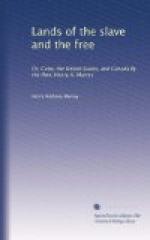The various fires with which the city has been visited, however distressing to the sufferers, have not been without their good effect, of which the eye has most satisfactory evidence in the numerous public and other buildings now built of stone. The only monument in the city is one which was raised to Nelson. Whether the memory of the hero has passed away, or the ravages of the weather call too heavily on the public purse, I cannot say; but it would be more creditable to the town to remove it entirely, than to allow it to remain in its present disgraceful state. It is reported that its restoration is to be effected by private subscription; if so, more shame to the authorities.
As nay first object was to reach Quebec, I only stayed one day at Montreal, which I employed in driving about to see what changes had taken place in the town and neighbourhood since my former visit in 1826. I started by steamer in the evening, and arrived early the next morning.
Is there any scene more glorious to look upon than that which greets the eye from the citadel at Quebec? The only scene I know more glorious is Rio Janeiro, which I believe to be by far the grandest in the world; but the Rio lacks the associations of Quebec. Who can ever forget that beneath its walls two chieftains, the bravest of the brave, fell on the same battle-field—the one in the arms of victory, the other in defence of his country and her honour? The spot where our hero fell is marked by a pillar thus simply inscribed:—
HERE DIED
WOLFE,
VICTORIOUS.
Nor has the noble foe been forgotten, though for a long time unnoticed. In the year 1827, the Earl of Dalhousie being Governor-General, a monument was raised in Quebec to Wolfe and Montcalm; and the death they both met at the post of honour is commemorated on the same column,—a column on which an Englishman may gaze with pride and a Frenchman without a blush. The following words, forming part of the inscription, I think well worthy of insertion: “Military prowess gave them a common death, History a common fame, Posterity a common monument.”
It is a curious fact, that when the foundation-stone was laid, an old soldier from Ross-shire, the last living veteran of the gallant band who fought under Wolfe, was present at the ceremony, being then in his ninety-fifth year. Everybody who has seen or read of Quebec must remember the magnificent towering rock overhanging the river, on the summit of which the citadel is placed, forming at once the chief stronghold of its defence, and the grandest feature of its scenery. But perhaps everybody does not know that to this same glorious feature the city owes its name. The puny exclamation of Jacques Cartier’s Norman pilot upon beholding it was, “Que bec!” and this expression of admiration has buried, in all but total oblivion, the old Algonquin name of Stadacona. What a pity that old pilot was not born dumb.




